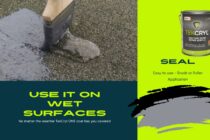Master the Application of GRP Roofing Topcoat
Your Guide to Applying GRP Roofing Topcoat
Discover the essential steps for applying GRP roofing topcoat effectively. Ensure a durable and weather-resistant finish for your flat roof with our expert guidance.
Key Features of Our Roofing Topcoat
Superior Adhesion
Our topcoat ensures a strong bond with the surface, reducing the risk of peeling and extending the lifespan of your roof.
Weather Resistance
Engineered to withstand harsh weather conditions, our topcoat protects your roof from rain, UV rays, and temperature fluctuations.
Easy Application
Designed for ease of use, our topcoat can be applied smoothly with minimal tools, making it perfect for DIY enthusiasts and professionals alike.
Understanding the Application Process
Step 1
Prepare the Surface
Begin by ensuring your roof is clean and dry, removing any debris or loose materials for optimal adhesion.
Step 2
Mix the Topcoat
Thoroughly stir the topcoat, ensuring the catalyst is well integrated for a consistent application.
Step 3
Apply the Topcoat
Use a roller to evenly distribute the topcoat across the roof, focusing on achieving a smooth, uniform finish.
Top coating the roof Apply Topcoat at a ratio of 0.5-0.6kg per m2, this ensures the correct thickness and will prevent cracking under fluctuating temperatures
Quickly understand how to apply roofing topcoat to a flat roof. The Topcoat is a resin and should be treated in the same way as the base resin. It requires the addition of a catalyst for it to cure. Always try to apply the topcoat immediately after the laminate is semi-cured (can be walked on, no stickiness) If this is not possible then ensure the top coating is carried out within 24 hours to gain good bonding with the laminate.
Roofing Performance Metrics
Our roofing solutions have consistently demonstrated exceptional durability and weather resistance, ensuring long-lasting protection for your home.
Durability Index
Weather Resistance Score
Customer Satisfaction Rate
Installation Efficiency Rating
Common Questions About Roofing Topcoat
Applying a roofing topcoat can be a straightforward process, but it’s important to address common concerns to ensure a successful application. Here are some frequently asked questions to help guide you through the process.
What is the best weather condition to apply a roofing topcoat?
For optimal results, apply the topcoat on a dry day with temperatures between 10°C and 25°C. Avoid application during rain or extreme heat.
How long does the roofing topcoat take to dry?
The topcoat typically dries to the touch within 2-4 hours, but full curing can take up to 24 hours depending on weather conditions.
Can I apply a topcoat over an existing roof?
Yes, you can apply a topcoat over an existing roof, provided the surface is clean, dry, and free of any loose materials or debris.
How often should I reapply the roofing topcoat?
Reapplication is generally recommended every 5-7 years, depending on environmental exposure and wear.
What tools do I need for applying the roofing topcoat?
You’ll need a roller or brush, a mixing paddle, and protective gear such as gloves and goggles for safe application.
Is it necessary to use a primer before applying the topcoat?
Using a primer is advisable for surfaces that are porous or have never been coated before, as it ensures better adhesion of the topcoat.
Protect Your Roof with Our Premium Topcoat
Enhance the durability and longevity of your roof with our top-quality roofing topcoat. Perfect for ensuring a weather-resistant and robust finish, our products are designed to withstand the harshest conditions. Don’t wait—secure your roof’s future today with Composite Roof Supplies.


